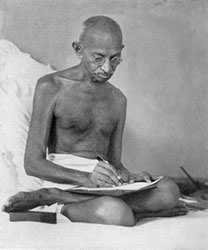
P.O. SEVAGRAM, DIST.WARDHA 442102, MS, INDIA. Phone: 91-7152-284753
FOUNDED BY MAHATMA GANDHI IN 1936
Short Stories For Everyone
Inspiring incidents from Gandhiji's Life: Selected from the book Everyone's Gandhi
(For the children in the age group of 10 to 15 years)

SHORT STORIES FOR EVERYONE
Gandhi's inspiring short stories selected from the book Everyone's Gandhi
Editor by : Rita Roy
Table of Contents
- All for A Stone
- A Car And A Pair of Binoculars
- My Master's Master
- Enter The Monkeys
- Premchand Quits His Job
- Returning His Medals
- Basic Pen
- Prisoner No. 1739
- Gandhi's White Brother
- Who Saw Gandhi?
- An Early School
- An Unusual March
- Spiritual Heir
- The Less You Have The More You Are
- An Old Goat Talks
- The Phoenix Settlement
- Gandhi in Amsterdam
- Something To Be Shy About?
- Gandhiji The Matchmaker
- Gandhi's Army
- Dandi Snippet
- Hiding Something
- The Image Maker
- Creative Reader
- Postcards To The Rescue
- A Non-violent Satyagraha 214 Years Ago
- Gandhi And Delhi
- Gandhiji's Constructive Programme
- Gandhi Looks At Leprosy
- Baba Amte
- They Gave Peace A Chance
- From Mahatma To God
- Customs Are Out of Fashion
- The Man 'Charlie' Wanted To Meet
- It Came Naturally To Him
- Crossing The Sea of Narrow-Mindedness
- Wear Clothes As They Should Be Worn
- Education: For Life, Through Life
- The Abode of Joy
- To Cling to A Belief
- The Fruit of A Child's Labour
- An Ideal Prisoner
- How A Film Became Something More
- Gandhi: Beyond India
- Gandhi's Life-Saving Medicine
- Understanding The Mechanics of Life With Gandhi
- The Lokmanya and The Mahatma
- Man's Gift To Nature
- Gurudev And His Mahatma
- One-man Boundary Force
- What Does Mahatma Gandhi's Message Mean To Me?
- Let's Play Together
- Children's Response To Conflict
- Beggar By Choice
- The Better Half
- Uncle Gandhi
- The Watch: An Instrument For Regulating Life
- Light The Lamp of Your Mind
- Gandhi's Bet!
- Gandhi Feeling At Home In The Kitchen
- What Is Simplicity?
- Bapu And The Sardar
- The Power of Quality
- Gandhi: The Teenager!
Chapter 38: Education: For Life, Through Life
N. Krishnaswamy
Mahatma Gandhi led the struggle for India's freedom so that a new social order could be established in our country. He had no quarrel with individual Englishmen but he was totally opposed to the British system of education and administration imposed in our country. While strengthening the Indian National Congress as a political instrument for achieving Indian Independence, he established number of institutions to build up a new society. One of the last such institutions was the Hindustani Talimi Sangh (The All-India Basic Education Society) to promote education based on a socially useful productive craft. It was meant to replace the mere book-centred system of education introduced by Lord Macaulay to produce only clerks for British Indian Companies.
When Gandhiji looked out for a suitable person to carry out the scheme of Nai Talim (Basic Education), his eyes fell on a couple who had been working at Tagore's Vishwabharati in Santiniketan. Shri E.W. Aryanayakam and his wife Smt. Asha Devi responded enthusiastically to Gandhiji's invitation to come to Sevagram.
Aryanayakam was a Jaffna Tamil from Sri Lanka, who had had his early education in what was then known as Ceylon and later in England. His wife, Asha Devi was a highly educated Bengali lady from Santiniketan. 'Nayakamji', as he was affectionately known, agreed with Bapu that unless the skills in some useful craft were acquired by the children and academic subjects were correlated to the craft, mere book-centred or play-based education would neither help the child to realize his full potential nor make him grow to be a good citizen.
Nayakamji's mother-tongue was Tamil. But he had mastered English language and had also picked up Bengali well enough in Santiniketan to feel at home there. He studied Hindustani and could communicate in the 'Rashtrabhasha' without difficulty. He was able to acquire a working knowledge of Marathi as well. He had an all-India perspective and felt as much at home in any part of India as in Sri Lanka; nay, nowhere in the world did he feel that he was a stranger.
Nayakamji followed a strict code of conduct in his personal life and was a strict disciplinarian. He and his wife led a simple life on a grand monthly allowance of Rs 75 each. It was a pleasure to watch him handle a teachers' training class or a class of small boys and girls. Like his Master, he would go on spinning while talking to visitors or giving directions to his staff. The couple brought to the austere atmosphere of Sevagram a touch of the aesthetic sense of Santiniketan.
Nayakamji and Asha Devi had to face a great personal tragedy when they lost their only son Anandmohan in Sevagram. However, the couple overcame their grief and sorrow by moving closer to the two hundred children that were then Studying in the Basic School in Sevagram.